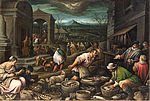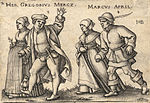March
![]()
The title of this article is ambiguous. For other meanings, see March (disambiguation).
March (abbreviation Mrz. or Mar.) is the third month of the year in the Gregorian calendar.
It has 31 days and is named after the Roman god of war Mars, after whom the Romans called it Martius. Originally, in this month, which marked the beginning of the campaign season, the Roman citizens fit for arms gathered on the so-called Field of Mars (or March Field) outside the gates of the city to be mustered and to choose their commanders.
The old Germanic name is Lenz, Lenzing or Lenzmond; an obsolete spelling is Märzen.
March 1 marks the meteorological beginning of spring. The equinox, the astronomical beginning of spring, usually takes place on March 20 over the next few decades (it last fell on March 21 in 2011). On this day the sun stands over the equator in the zenith and goes there thus exactly in the east on and exactly in the west under. The time moves always 3 years around something less than 6 hours forward, in order to jump then in the 4th year (leap year) again around 18 hours back. Because the jump back is greater than the forward movement, the beginning of spring moves backward when viewed over 4 years. To prevent the beginning of spring from moving through the entire year, the Gregorian calendar eliminates the leap year every 100 years unless the year is divisible by 400 (last 1900, next 2100, but not 2000). Therefore, the beginning of spring can occur between March 19 and 21, but will fall almost exclusively on the 19th and 20th until the year 2100.
The Roman calendar originally began with March as the first month. This is also the origin of the names of the months September (Latin septem 'seven'), October (Latin octo 'eight'), November (Latin novem 'nine') and December (Latin decem 'ten'), each named after its position in the sequence of months. On March 1 and March 15, respectively, the highest officials in Rome, the two consuls, after whom the respective year was named and who were the supreme army commanders, also took office. When the consuls took office in 153 B.C., the beginning of the year was postponed to January 1 for military reasons.
Under Emperor Commodus (180 to 192 AD), the month was renamed Felix, one of his epithets. After the emperor's death, however, it was returned to its old name.
March always begins with the same day of the week as November and, in non-leap years, as February.
· 
Yellow daffodil or daffodil (Narcissus pseudonarcissus)
· 
March, Leandro Bassano
· 
The month of March in the chronograph of 354 by the late antique calligrapher Filocalus.
· 
The months of March and April, copperplate engraving by Sebald Beham, 1546
See also
- Movable holidays
- Movable commemorative days
- Equinox
- March
- List of farmer's rules
Questions and Answers
Q: What is the third month of the year in the Gregorian calendar?
A: March is the third month of the year in the Gregorian calendar.
Q: How many days does March have?
A: March has 31 days.
Q: What Roman god does March get its name from?
A: March is named after Mars, the Roman god of war.
Q: Does March always begin on the same day of the week as November and February in common years?
A: Yes, March always begins on the same day of the week as November and February in common years.
Q: Does March always end on the same day of the week as June?
A: Yes, March always ends on the same day of the week as June.
Q: Is there a difference between a leap year and a common year when it comes to February's start date for march?
A: No, there is no difference between a leap year and a common year when it comes to February's start date for march.
Search within the encyclopedia